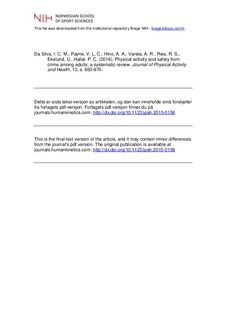| dc.contributor.author | Da Silva, Inacio C. M. | |
| dc.contributor.author | Payne, Valerie L. C. | |
| dc.contributor.author | Hino, Adriano Akira | |
| dc.contributor.author | Varela, Andrea Ramirez | |
| dc.contributor.author | Reis, Rodrigo S. | |
| dc.contributor.author | Ekelund, Ulf | |
| dc.contributor.author | Hallal, Pedro C. | |
| dc.date.accessioned | 2017-02-16T09:35:11Z | |
| dc.date.available | 2017-02-16T09:35:11Z | |
| dc.date.issued | 2016 | |
| dc.identifier.citation | Journal of Physical Activity and Health. 2016, 13 (6), 663-670 | nb_NO |
| dc.identifier.uri | http://hdl.handle.net/11250/2431007 | |
| dc.description | I Brage finner du siste tekst-versjon av artikkelen, og den kan inneholde ubetydelige forskjeller fra forlagets pdf-versjon. Forlagets pdf-versjon finner du på journals.humankinetics.com / In Brage you'll find the final text version of the article, and it may contain insignificant differences from the journal's pdf version. The definitive version is available at journals.humankinetics.com | nb_NO |
| dc.description.abstract | Background: The aim of this study was to review the evidence to date on the association between physical activity and safety from crime. Methods: Articles with adult populations of 500+ participants investigating the association between physical activity and safety from crime were included. A methodological quality assessment was conducted using an adapted version of the Downs and Black checklist. Results: The literature search identified 15,864 articles. After assessment of titles, abstracts and full-texts, 89 articles were included. Most articles (84.3%) were derived from high-income countries and only 3 prospective articles were identified. Articles presented high methodological quality. In 38 articles (42.7%), at least one statistically significant association in the expected direction was reported (ie, safety from crime was positively associated with physical activity). Nine articles (10.1%) found an association in the unexpected direction and 42 (47.2%) did not find statistically significant associations. The results did not change when we analyzed articles separately by sex, age, type of measurement, or domains of physical activity evaluated. Conclusions: The current evidence, mostly based on cross-sectional studies, suggests a lack of association between physical activity and safety from crime. Prospective studies and natural experiments are needed, particularly in areas with wide crime variability. | nb_NO |
| dc.language.iso | eng | nb_NO |
| dc.publisher | Human Kinetics | nb_NO |
| dc.subject | insecurity | nb_NO |
| dc.subject | environment | nb_NO |
| dc.subject | physical activity correlates | nb_NO |
| dc.title | Physical activity and safety from crime among adults: a systematic review | nb_NO |
| dc.type | Journal article | nb_NO |
| dc.type | Peer reviewed | nb_NO |
| dc.subject.nsi | VDP::Medisinske Fag: 700::Helsefag: 800::Forebyggende medisin: 804 | nb_NO |
| dc.source.journal | Journal of Physical Activity and Health | nb_NO |
| dc.identifier.doi | 10.1123/jpah.2015-0156 | |
| dc.description.localcode | Seksjon for idrettsmedisinske fag / Department of Sports Medicine | nb_NO |
